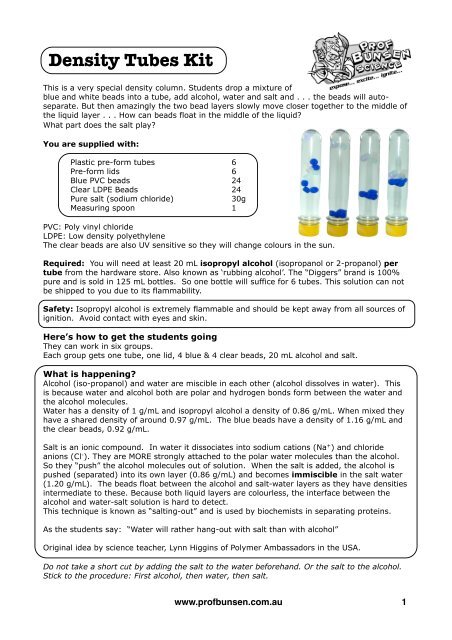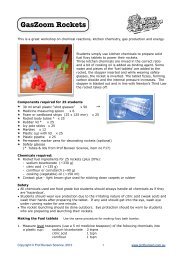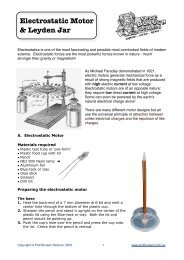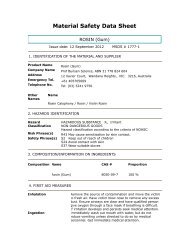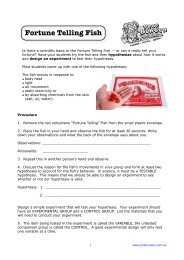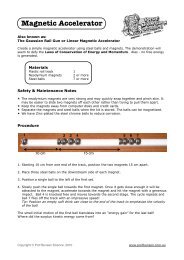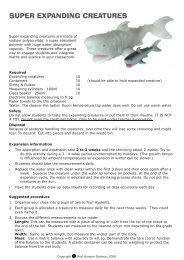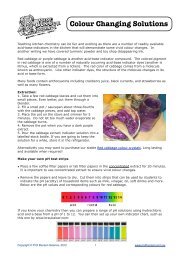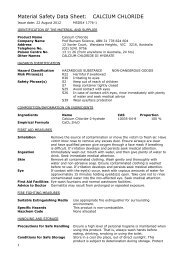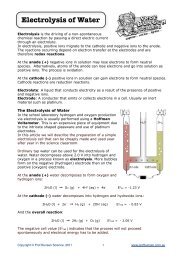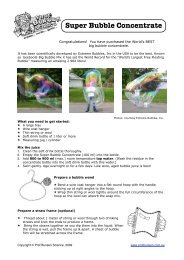Create successful ePaper yourself
Turn your PDF publications into a flip-book with our unique Google optimized e-Paper software.
<strong>Density</strong> <strong>Tubes</strong> Kit<br />
This is a very special density column. Students drop a mixture of<br />
blue and white beads into a tube, add alcohol, water and salt and . . . the beads will autoseparate.<br />
But then amazingly the two bead layers slowly move closer together to the middle of<br />
the liquid layer . . . How can beads float in the middle of the liquid<br />
What part does the salt play<br />
You are supplied with:<br />
Plastic pre-form tubes 6<br />
Pre-form lids 6<br />
Blue PVC beads 24<br />
Clear LDPE Beads 24<br />
Pure salt (sodium chloride)<br />
30g<br />
Measuring spoon 1<br />
PVC: Poly vinyl chloride<br />
LDPE: Low density polyethylene<br />
The clear beads are also UV sensitive so they will change colours in the sun.<br />
Required: You will need at least 20 mL isopropyl alcohol (isopropanol or 2-propanol) per<br />
tube from the hardware store. Also known as ‘rubbing alcohol’. The “Diggers” brand is 100%<br />
pure and is sold in 125 mL bottles. So one bottle will suffice for 6 tubes. This solution can not<br />
be shipped to you due to its flammability.<br />
Safety: Isopropyl alcohol is extremely flammable and should be kept away from all sources of<br />
ignition. Avoid contact with eyes and skin.<br />
Here’s how to get the students going<br />
They can work in six groups.<br />
Each group gets one tube, one lid, 4 blue & 4 clear beads, 20 mL alcohol and salt.<br />
What is happening<br />
Alcohol (iso-propanol) and water are miscible in each other (alcohol dissolves in water). This<br />
is because water and alcohol both are polar and hydrogen bonds form between the water and<br />
the alcohol molecules.<br />
Water has a density of 1 g/mL and isopropyl alcohol a density of 0.86 g/mL. When mixed they<br />
have a shared density of around 0.97 g/mL. The blue beads have a density of 1.16 g/mL and<br />
the clear beads, 0.92 g/mL.<br />
Salt is an ionic compound. In water it dissociates into sodium cations (Na + ) and chloride<br />
anions (Cl - ). They are MORE strongly attached to the polar water molecules than the alcohol.<br />
So they “push” the alcohol molecules out of solution. When the salt is added, the alcohol is<br />
pushed (separated) into its own layer (0.86 g/mL) and becomes immiscible in the salt water<br />
(1.20 g/mL). The beads float between the alcohol and salt-water layers as they have densities<br />
intermediate to these. Because both liquid layers are colourless, the interface between the<br />
alcohol and water-salt solution is hard to detect.<br />
This technique is known as “salting-out” and is used by biochemists in separating proteins.<br />
As the students say: “Water will rather hang-out with salt than with alcohol”<br />
Original idea by science teacher, Lynn Higgins of Polymer Ambassadors in the USA.<br />
Do not take a short cut by adding the salt to the water beforehand. Or the salt to the alcohol.<br />
Stick to the procedure: First alcohol, then water, then salt.<br />
www.profbunsen.com.au 1
DENSITY TUBES<br />
STUDENT WORKSHEET<br />
Procedure<br />
The object is to separate the two types of beads using two liquids and salt and the<br />
principle of density.<br />
1. Add 4 blue and 4 clear beads to the tube.<br />
2. Fill the tube half way with the alcohol (isopropanol).<br />
3. Cap and shake the mixture.<br />
4. Stop shaking, observe and sketch where the beads and liquid are in figure 1.<br />
5. Complete: The _______________ are more dense than the _______________.<br />
6. Add water up to the protruding lip of the tube. Cap, shake, observe.<br />
7. Sketch the position of the liquid and beads in figure 2.<br />
8. Complete: The liquid (water-alcohol solution) is more / less dense than the clear<br />
beads but more / less dense than the blue beads.<br />
9. If a water-alcohol solution has a density of 0.97 g/mL, what would you guess the<br />
density be of the<br />
blue beads __________ g/ml<br />
clear beads __________ g /ml<br />
10. Measure 5 g of the salt and pour all of it into the tube. (This is about ⅔ of the<br />
medicine measuring spoon supplied). Cap and shake . . . and shake . . . and<br />
shake. Until most of the salt has dissolved. This may take several minutes.<br />
11. Invert the tube (turn around) on its cap and watch closely. If the beads do not<br />
separate and move as in the photo on p 1, dissolve more salt or add a few crystals.<br />
12. Sketch the layers and position of the beads after 2 minutes (Figure 3).<br />
13. Put names to the densities in Table 1.<br />
14. Can you see where the two clear liquid layers meet in the tube (the interface)<br />
15. Can you explain the unexpected movement of the beads when salt was added<br />
www.profbunsen.com.au 2
DENSITY TUBES<br />
Group Name: _______________________________ Date: __________________<br />
Group members: _____________________________________________________<br />
____________________________________________________________________<br />
Figure 1<br />
Alcohol & beads<br />
Figure 2<br />
Alcohol, water<br />
& beads<br />
Figure 3<br />
Alcohol, water,<br />
salt & beads<br />
(After 2 minutes)<br />
Below we listed the densities of the substances / mixes in the test tube in Figure 3.<br />
Can you put names to the densities<br />
Table 1<br />
0.86 g/ml ____________________<br />
0.92 g/mL ____________________<br />
1.16 g /mL ____________________<br />
1.20 g/mL ____________________<br />
Figure 4<br />
www.profbunsen.com.au 3


